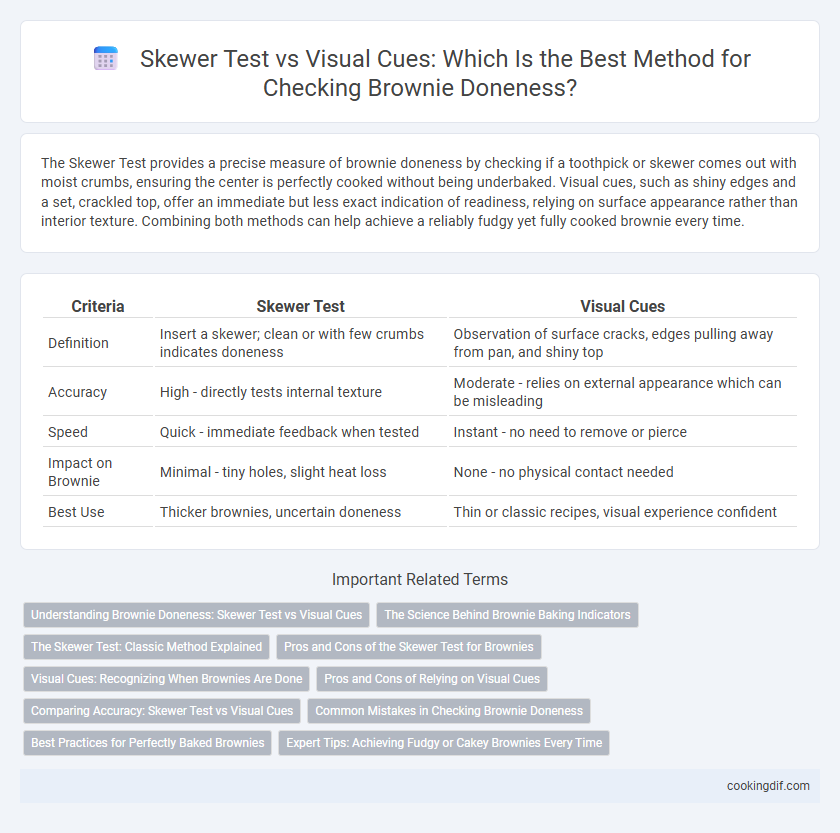The Skewer Test provides a precise measure of brownie doneness by checking if a toothpick or skewer comes out with moist crumbs, ensuring the center is perfectly cooked without being underbaked. Visual cues, such as shiny edges and a set, crackled top, offer an immediate but less exact indication of readiness, relying on surface appearance rather than interior texture. Combining both methods can help achieve a reliably fudgy yet fully cooked brownie every time.
Table of Comparison
| Criteria | Skewer Test | Visual Cues |
|---|---|---|
| Definition | Insert a skewer; clean or with few crumbs indicates doneness | Observation of surface cracks, edges pulling away from pan, and shiny top |
| Accuracy | High - directly tests internal texture | Moderate - relies on external appearance which can be misleading |
| Speed | Quick - immediate feedback when tested | Instant - no need to remove or pierce |
| Impact on Brownie | Minimal - tiny holes, slight heat loss | None - no physical contact needed |
| Best Use | Thicker brownies, uncertain doneness | Thin or classic recipes, visual experience confident |
Understanding Brownie Doneness: Skewer Test vs Visual Cues
Understanding brownie doneness requires accurately distinguishing between underbaked and perfectly cooked textures, with the skewer test and visual cues serving as primary methods. The skewer test involves inserting a clean toothpick or skewer into the center of the brownie; moist crumbs indicate optimal doneness, while wet batter suggests undercooking. Visual cues such as shiny surfaces, cracked tops, and slightly pulling edges complement this assessment, helping bakers achieve the ideal fudgy or cakey consistency.
The Science Behind Brownie Baking Indicators
The skewer test and visual cues both assess brownie doneness by evaluating moisture and structural changes during baking. The skewer test measures internal moisture by inserting a thin implement to check for wet batter, while visual cues analyze surface cracking and color transformation indicating Maillard reactions. Scientific understanding of heat transfer and protein coagulation explains why both methods, when used together, provide reliable indicators of optimal brownie texture and flavor.
The Skewer Test: Classic Method Explained
The skewer test remains the classic method for checking brownie doneness, where a toothpick or skewer is inserted into the center to assess moisture levels. If the skewer comes out with moist crumbs but no raw batter, the brownies are perfectly baked, ensuring a fudgy texture. This simple technique offers a reliable indicator, avoiding overbaking and maintaining the desired dense consistency.
Pros and Cons of the Skewer Test for Brownies
The skewer test for brownies provides a simple and quick method to check doneness by inserting a thin stick into the center to see if it comes out clean or with moist crumbs. Its main advantage is that it helps prevent overbaking, preserving the fudgy texture, but it may not detect subtle underbaking since moist crumbs can vary depending on the recipe's moisture content. The test can also create small holes that slightly affect the brownie's appearance, making visual cues like shiny tops and set edges a complementary approach for more accurate doneness assessment.
Visual Cues: Recognizing When Brownies Are Done
Visual cues for determining brownie doneness include observing a set, glossy top with slightly cracked edges and the center appearing moist but not wet. The edges typically begin to pull away from the pan, signaling readiness without relying on skewer tests. These visual indicators help prevent overbaking, ensuring fudgy, perfectly cooked brownies every time.
Pros and Cons of Relying on Visual Cues
Relying on visual cues for brownie doneness offers quick and straightforward assessment, such as noticing a shiny, cracked top or edges pulling away from the pan, but it may lead to inconsistent results due to variations in oven temperatures and batter thickness. Visual cues alone can be misleading because they don't always reveal the interior texture, risking underbaked, gooey centers or overly dry brownies. Compared to the skewer test, which provides direct evidence of moisture content by detecting wet batter on the inserted tool, visual cues require more experience and intuition to accurately judge doneness.
Comparing Accuracy: Skewer Test vs Visual Cues
The skewer test provides a more precise measurement of brownie doneness by detecting moist crumbs or wet batter, ensuring accurate timing for removal from the oven. Visual cues such as cracked edges and a set center can be subjective and vary by oven type, leading to inconsistent results. Compared to visual inspection, the skewer test reduces the risk of underbaking or overbaking, contributing to a perfectly fudgy or cakey texture based on preference.
Common Mistakes in Checking Brownie Doneness
Common mistakes in checking brownie doneness often involve relying solely on the skewer test, which can give false positives if crumbs cling to the probe, misleading bakers to underbake or overbake. Visual cues like the slightly cracked top, set edges, and a glossy surface provide more accurate signals of perfect doneness, preventing the dry texture caused by excessive baking. Combining both methods while understanding their limitations ensures optimal fudgy or cakey brownie results.
Best Practices for Perfectly Baked Brownies
Skewer tests assess brownie doneness by inserting a toothpick into the center and checking for moist crumbs, ensuring a fudgy texture without underbaking. Visual cues such as slightly pulled away edges and a matte, crackled surface indicate proper baking and help avoid dry brownies. Combining both methods offers the most reliable approach to achieve perfectly baked brownies with ideal consistency.
Expert Tips: Achieving Fudgy or Cakey Brownies Every Time
Use the skewer test by inserting a toothpick into the center of the brownie; fudgy brownies show moist crumbs clinging to the skewer, while cakey brownies have a cleaner, less moist result. Visual cues such as slightly pulling away edges and a shiny, cracked top indicate brownies are properly baked and ready to remove from the oven. Expert bakers emphasize combining both methods for precise doneness, ensuring brownies match the desired texture every time.
Skewer Test vs Visual Cues for doneness Infographic

 cookingdif.com
cookingdif.com